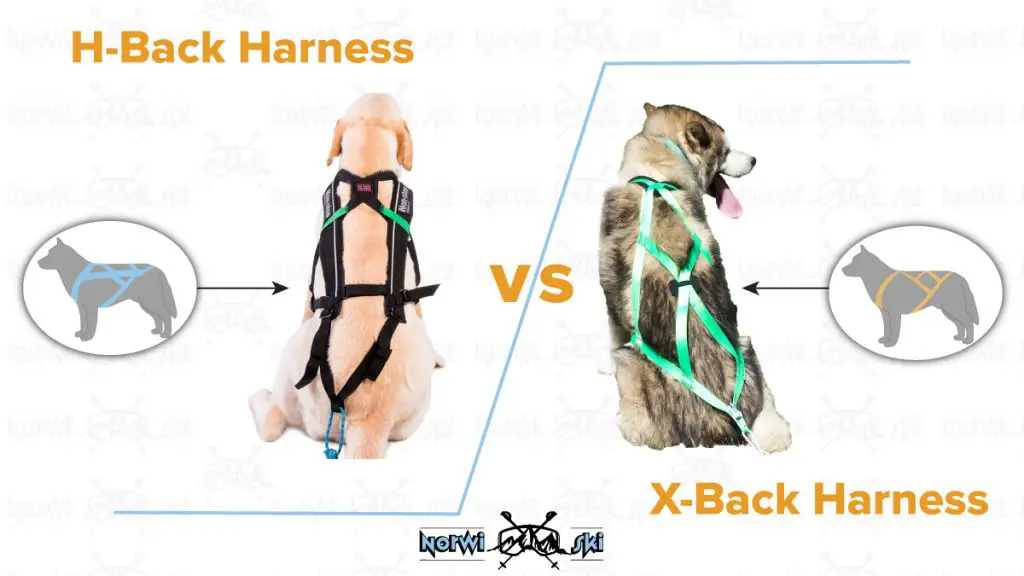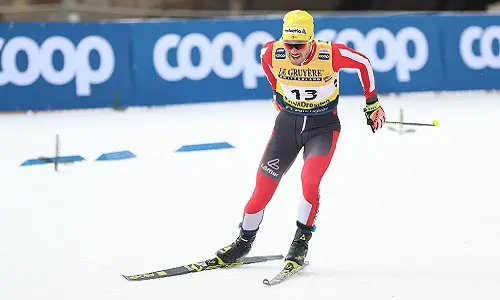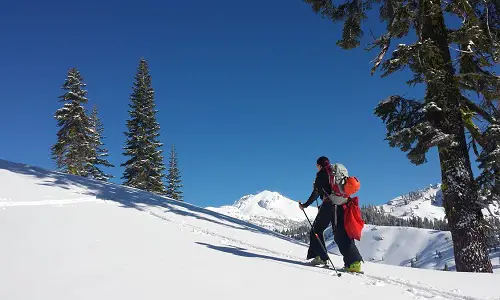Table of Contents
Skijoring literally means ski driving in Norwegian and is a great winter sport in which you are either pulled on cross-country skis by dogs, a motor vehicle or a horse – this latter is called equestrian skijoring. In this article, we are going to focus on dog skijoring, a wonderful sport that lets you bond with your dog and enjoy the winters at the same time.
Dog skijoring is an outdoor winter activity that combines cross country skiing with a dog on a sled dog harness. The cross country skier uses the power from the skis and the poles whereas the dog adds more sliding power by running in the front and pulling the skier. The skier often gives verbal commands to the dog to coordinate with the furry athlete.
Cross-Country Skiing with Your Dog
Dog skijoring is not a new sport and has been there for hundreds of years. However, it is gaining more popularity these days due to people involving their dogs in their winter activities. It is much easier to learn than dog sledding and more tour companies and races are featuring skijoring. This is enabling dog lovers to recognize it as a proper sport that they can take part in along with their dogs. The best part is skijoring does not require much special equipment which makes it accessible to anyone who loves cross country skiing and owns a dog.
Historic Roots
The origin of skijoring dates back to the 1850s where it was a popular activity as well as means of transportation in Scandinavia. The word skijoring is derived from the Norwegian word for “ski driving” as it combines cross country skiing and dog sledding. You can engage from one to three dogs in skijoring. The dog wears a dog sledding harness which is attached by a towline or a rope to a skijoring harness that the skier puts on. If your dog loves to run in the snow and you have a passion for cross country skiing, there is no better win-win activity than skijoring.
The skijoring dog should weigh at least 35 pounds (though 50 pounds and up is even better) and should be able to pull the skier with willingness and energy. The skier will also add to this momentum and force by using his/ her cross country skis as well as poles. Your dog should be healthy and needs some basic training to get started, but the good news is that you do not have to be an expert in either cross country skiing or skijoring to enjoy this activity.
You also do not have to have a Northern breed such as a Malamute or Husky to do this sport. Also, your dog does not have to be a big dog, a medium size of dog will work great as well, as you will be adding to the momentum. Make sure you take your dog for a checkup to verify he/ she is healthy, and you (and your dog) are good to go for skijoring!
Modern Sport and Recreation
Today, dog skijoring is one of the more popular winter activities around the world and it has become the most loved dog-friendly activity of the US’s winter season. So why not try it? When the temperature drops and the snow begins to fall, take your dog on a skijoring adventure, and you will know why so many cross country skiers are in love with this activity.
Since it’s a great recreational activity for both you and your dog, make sure the equipment used is designed for skijoring purposes. The first rule is not going with metal edge skis. In case you and your dog tangle up or have a collision due to an unmatched pace, the metal-edged skis could hurt the canine, and even you too. Most of the skijoring enthusiasts normally use waxless classic skis; some also use backcountry-style skis. If you plan to ski on groomed surfaces, you can also use skate skis.

If you are new to cross country skiing, it is best to consult someone good at XC skiing before purchasing your skis, bindings, and ski boots. A ski professional can offer you a package at a good deal including the equipment you need for skijoring. But do not worry, skijoring requires minimal equipment but offers tons of fun.
Skijoring is a great recreational activity, but some skiers want more! If you are one of those and are aiming to take part in skijoring competitions, you should talk to experienced skijorers to learn more about this sport and what you should be looking for in the competitions. It is also a good idea to inquire about the breeds that are best suited for competitions. You would also not want your canine to carve his/ her own route and not listen to you. The ideal skijoring dog is the one that ignores the presence of other dogs on the skijoring trail and keeps on running upon your instructed route.
In skijoring competitions, if a dog is distracted by the presence of other dogs or even worse, interferes with others, this leads to deduction in points. Just like other canine events, skijoring competitions and races have crowds of dogs belonging to different breeds. The last thing you want is to be in the middle of a dog fight with your cross country skis on!
Necessary Equipment
Skijoring requires minimal equipment, but you need to make sure the skijoring gear has a great quality as you would not want to take any risks with yours or your dog’s wellbeing. You can buy the skijoring equipment as part of a skijoring package where all the equipment come in an all-in-one packaging, or you can choose to buy these gear separately. In some instances, though buying a package is easier and less hassle, buying them separately can save you some bucks.
Pulling Harness
Dogs come in different shapes, sizes, and weights, so it is best to have a custom made sled dog harness for your dog’s exact fit. Having said that, there are great options for dog harnesses available and you can choose the right one for your canine friend. Just make sure you do not pull your dog by the collar as it will put a great amount of pressure on the neck vertebrae and could even restrict your four-legged friend’s breathing. Also, the dog walking harnesses should not be used in skijoring as they not designed for active pulling.

There are different types of dog harnesses:
- X-Back or Cross-Back Harness
- H-Back Harness
- Half Back Harness
- Wheel Dog Harness
The Cross-Back or X-Back harness is specially designed with the straps crossed on the dog’s back ending at the tail, hence the name. The tether is attached at the tail end and this type of harnesses is typically used with Alaskan Malamutes and Siberian Huskies. The X-shaped design enables a proper load distribution on your dog’s body which results in optimal force transmission.
The X-Back harness is a great harness for skijoring. However, it cannot be adjusted so make sure it fits your dog perfectly. The neck opening of the harness needs to be fit – not too tight that it leaves a mark on your dog’s skin or feels like choking him though. The end piece of the X-Back harness needs to begin at the base of the tail and side straps should be located within the coastal arch, not behind the arch. The harness should not slip when the dog moves, instead, it should move along with your dog.
The H-Back Harness is ideal for beginners in skijoring as the harness can be adjusted giving the new skijorer more room. It also works great in case your dog is new to skijoring as your dog can find the right pulling direction using the harness. In case you have a lean and long dog or one who does not have a typical shape of a sled dog, these harnesses can be ideal for your canine.
The H-shape of this harness can be easily identified from the rest of the harnesses. This H-shape takes the pressure off your canine’s back and facilitates unrestrained breathing of your dog while he/ she pulls you along. In short, the H-Back harness offers you and your racing partner a great balance between running freely and transmitting power to keep up with the pace.
The shorter Half Back Harness is good for deep-chested canine as well as small-sized dogs. It may seem like the harness that you use for leashed walking but unlike the walk-leash, the half-back harness can pull weight. It is not ideal for kick sledding. For kick sledding, it is recommended that you use the Wheel Dog Harness that does not exert any pressure on the hind end of your dog.

Towline
A skijoring towline is specially designed with elastic to absorb the shock from sudden movement, the dog’s forward motion or standstill. What if your dog starts running while you are at a standstill? The towline absorbs the shock and should ideally max out between 8 to 10 feet to give room for your skis as well as giving you enough stopping distance so you do not end up having a collision with your canine friend.
If you are skijoring with two dogs, you can get a gear to connect their harnesses into one so the dogs can run alongside each other.
Hip Belt
The skijoring belt is a wide and padded hip belt that gives the cross country skier comfort during the skijoring activity. The skier wears it around his/ her hips, and not the waist (to prevent any shock or damage to the lower back). While looking for your hip belt, make sure you measure yourself properly and keep into account the fact that you will be wearing the hip belt on top of your winter clothes.
Hip belts often come with extra features like having a water bottle holder or a treat pouch. They also have loops where you can attach your small gear pouches. In case of an emergency, you should be able to quickly detach yourself from the skijoring line.
Dog Jacket (Optional)
Having a dog jacket for your skijoring buddy is a great idea to protect your four-legged from the extreme cold. Some dogs have a thick coat or a double coat and they may not need a dog jacket. For others, you may need a dog jacket to keep them warm.
Paw Wax
It is also important to protect your dog’s paws from harsh elements such as ice, salt, and sand. The paw protection wax keeps the paws of your dog well-protected. The wax comes in an easy to apply cream and keeps your furry friend safe from injury caused by outdoor winter activities.
Training Your Dog for Skijoring
It is important to train your dog for skijoring so he/ she knows what to do when you are out in the snow with him. With patience and some dog treats (or many treats, depending upon your dog), you will be able to train your canine easily.
</ br>
Keep the following points in mind while training your dog for skijoring:
- Start training on dry land without hooking your dog up to his/ her harness. Once you introduce harness, make sure your dog is comfortable in the gear before you start with commands.
- Use clicker training and positive reinforcement. Dogs are generally quick learners and as soon as they realize that the harness is linked to their happy time outdoors, they will quickly adapt to their skijoring training routine.
- If you want to sign your dog and yourself up for a skijoring race, do lots of practice at home, and ideally take help from any local skijoring club.
- Learn the commands and make sure your dog understands these commands well and differentiates between each command.
- Keep the training as much fun as possible. When the two of you have fun in training, chances are that your dog will learn the sport quickly and you will not lose patience while teaching him/ her.
If you are not sure about the commands, here are some of the basic sled dog commands that you can teach your dog. Try practicing them with your canine, and reward him/ her when he/ she understand or responds accordingly.
- Hike, Mush, or All Right: Get moving.
- Kissing sound: Move faster.
- Easy: Slow down.
- Whoa: Stop.
- On By: Pass a certain distraction or another team or skijoring.
- Haw: Turn to the left.
- Gee: Turn to the right.
You need to note that voice commands should not be words that are often used in your common conversation. It is natural for you and your dog to struggle in the beginning. Make sure you use a lot of encouragement and praise. Do not get upset or punish your dog for not getting the commands. This training should be a fun time for both of you.
When starting, keep the training session under 15 minutes and slowly increase the time. It may take a couple of months for your dog to perfectly figure out the commands so be patient. It would be worth it in the long run.
Conclusion
Skijoring is fun – for both you and your canine friend. Make sure your dog qualifies for the sport by being healthy, active, willing to run, and have a minimum weight of 35 pounds. You and your dog must have the right skijoring gear before stepping out. In order to have some fun in the snow with your dog, you need to train him/ her properly and show patience while doing so. The dog should not get too far or lag when skijoring, and keep the pace fluid. Practice voice commands for stopping, turning, speeding up, and slowing down with your dog. Once you are your furry friend are ready for skijoring, you are guaranteed to have a lot of fun in the winters to come.


